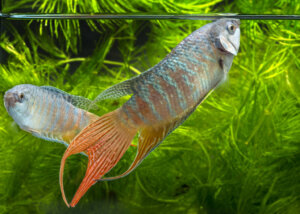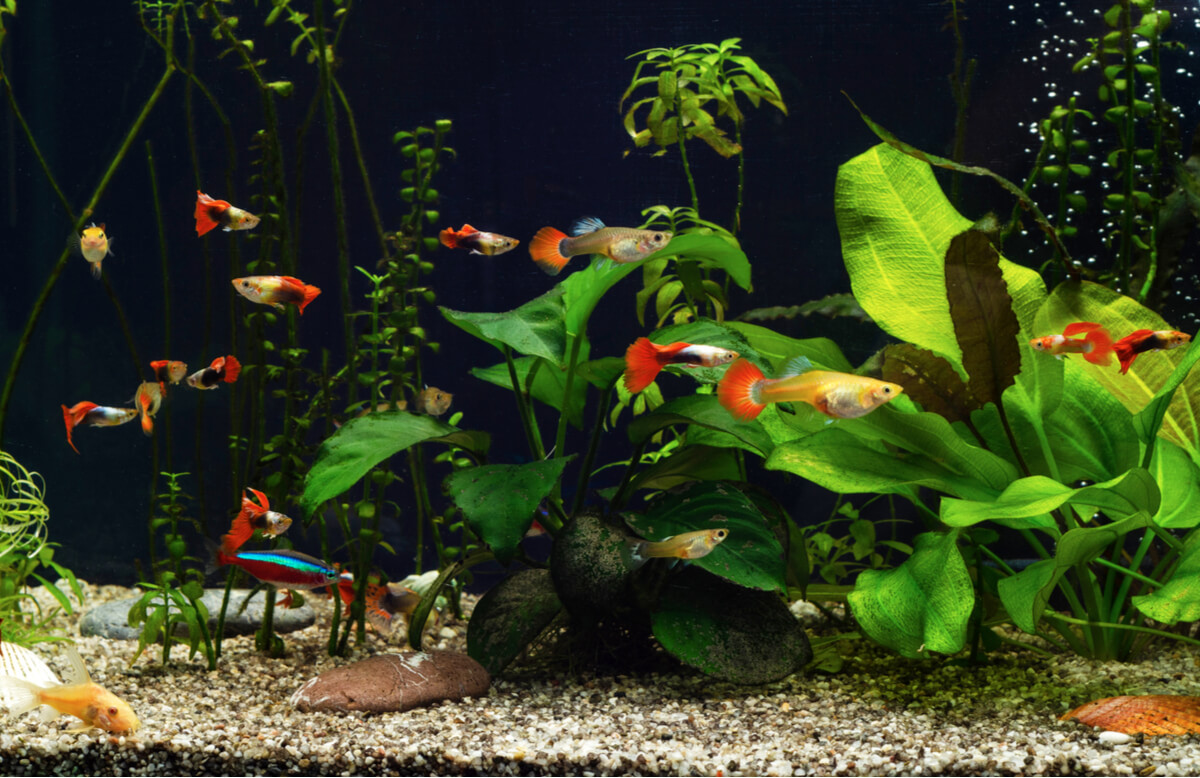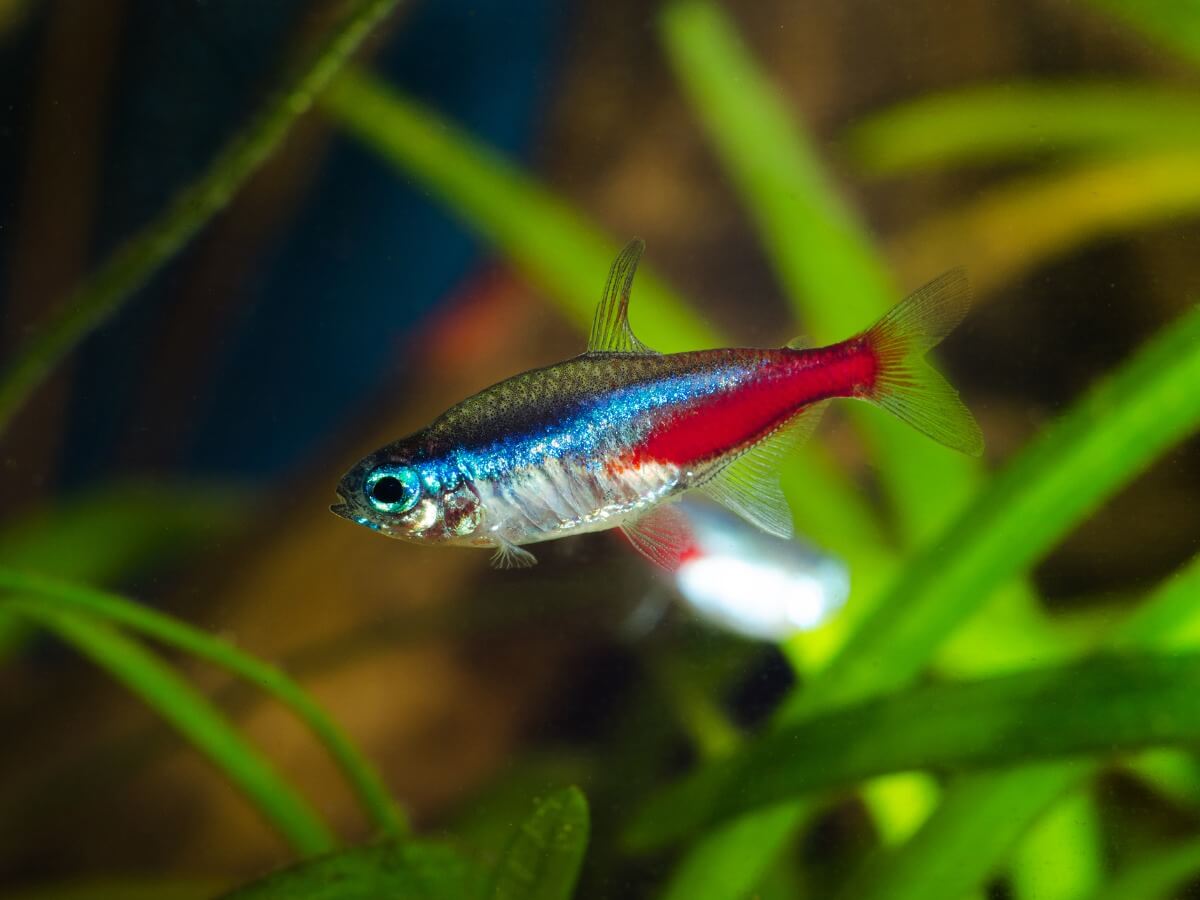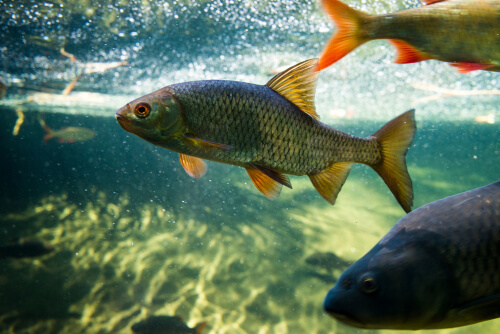9 Fish that Don't Need a Filter in the Fish Tank


Written and verified by the biologist Ana Díaz Maqueda
Aquarium keeping is, in itself, a complex hobby due to all the factors that can influence the health of your fish. Despite this, one of the growing trends in this hobby is to try to acquire fish that don’t need a filter in to live in the fish tank.
If keeping a clean and healthy tank is already a difficult task, having an aquarium without a mechanical filter is a challenge that seems to fascinate fanatics. Would you like to know how to keep an aquarium without a filter and which fish don’t need a filter? Keep reading and we’ll tell you!
First steps to have an aquarium without a filter
If you have decided to keep an aquarium without a filter, before placing the animals that do not need a filter to live, you must take into account several things. Lacking this essential object in most tanks, you will have to dedicate a double effort to prevent the water from losing quality.
Aquariums without filters require very frequent water changes. Also, you should be very careful with the additives to treat the water that you add to the tank, as well as the medications that are administered to its members.
Something that all aquariums without filters should have are natural plants that require little light and grow slowly, as many species of aquarium fish are natural filter feeders. Through photosynthesis, they don’t only oxygenate the water and remove CO2, but also filter out nitrogenous compounds that are harmful to fish with their roots.
On the other hand, plants will compete with algae for nutrients and control their expansion. Selecting plants that require little light will also prevent algae overgrowth inside the aquarium.
Animals that don’t need filters and live healthily in an aquarium
Not all fish can live in the conditions offered by an unfiltered aquarium. Likewise, you should select animals that produce little waste or at least spend part of their time cleaning the aquarium. Here’s a list of fish that don’t need filters in the tank.
1. Paradise fish
The only requirement for the paradise fish (Macropodus opercularis) is an adequate tank size, which should be at least 80 liters. Otherwise, this fish needs no filters, heater, or bubblers.
This species adapts very well to fluctuating changes in water conditions. In addition, it can withstand temperatures from 10ºC to 22ºC (50 to 72 F). It’s one of the easiest animals to keep in an aquarium without filters.

2. Guppies
Guppy fish (Poecilia reticulata) are fish that don’t need a filter in the tank in order to be healthy. Like the paradise fish, this species needs a tank of at least 80 liters, because, even though they’re very small fish, they need to live in large schools.
Guppies require a temperature between 22 and 28ºC (72 to 82 F), so they need a heater in most cases. Also, cleaning their tank is easy, as they eat and defecate little.

3. White Cloud Mountain minnow
The White Cloud Mountain minnow (Tanichthys albonubes) is one of the best fish for beginner aquarists. These animals are easy to keep, don’t grow much and don’t need a heater. In fact, the water shouldn’t exceed 22 ºC (72 F), as they’re native to high mountain rivers.

4. Bronze Corydoras
In general, almost all species of corydoras do well in an aquarium without filters, but they should be kept in small groups because they’re social animals. For this reason, the tank housing these fish should be large, about 100 liters in volume.
The best thing about cory fish is that they’re the ultimate cleaning crew for an unfiltered aquarium, as they’ll eat whatever other fish waste. However, debris isn’t the only basis of their diet and it’s important that you feed them specialized pellets for bottom fish.
Finally, if you decide to integrate cory fish in your aquarium, you should know that it can’t have a sharp substrate, but one based on sand and gravel that doesn’t damage their delicate skin.

5. Betta fish
The betta fish or Siam fighters (Betta splendens) are also fish that don’t need a filter to live in the aquarium. The problem with this species is that it can’t live with any other fish due to its unusual aggressiveness.
With no one else fouling the betta’s tank except itself, the water will be sparkling clean. Even so, you should be sure to perform periodic water changes every 3-4 days, so that bacteria and other pathogens don’t accumulate.

6. Common Pleco
Another fish that does a good job in the aquarium and doesn’t need a filter is the common pleco (Hypostomus plecostomus). This fish will eat all the algae that appear in the aquarium. However, they also have two major disadvantages that must be taken into account:
- They produce a lot of waste.
- When they’re adults, they should move to a larger tank with a filter, as they become a bit lazy and don’t eliminate as much algae.

7. Goldfish
Apart from its beautiful color, the goldfish (Carassius auratus) is highly resistant to adverse conditions in the water. This means that it withstands the presence of nitrites, lack of oxygen and even liquid turbidity, and so it’s a great choice for an unfiltered tank.
There are many varieties of goldfish and they all have the same resistance. However, some can grow too big and reach up to 90 centimeters (36 inches) in length, which would make it necessary to purchase another, larger tank. Of course, development is gradual and only the specimens with the greatest longevity reach such sizes.

8. Tetra fish
Tetra fish are actually several different species that are part of the Caraccidae family. They’re characterized by their small size, relatively low cost, and bright colors (some specimens). In addition, they tend to make very little mess in the aquarium, so they aren’t difficult to clean.
The only problem with these fish is that they need to be in a group. This means that a large tank is needed to keep at least 6 or 7 specimens at the same time.

9. Common carp
The common carp (Cyprinus carpio) is probably not your first choice as a pet, as they don’t usually sport dazzling colors or flashy fins. However, they’re one of the hardiest types of fish around and can adapt to almost any environment. Because of this, they’re the best choice for unfiltered aquariums.
The biggest problem with this species is its size, as adults are capable of reaching 90 centimeters (36 inches) in length. In addition, due to this characteristic, it’s normal for them to have problems of aggressiveness with other small fish. So, it’s better to choose to keep them in a large aquarium where only carp live.

We already know that this wonderful world is very complex and a lot of research must be done to keep an aquarium in good condition. Even if you want to keep a tank without a filter, the first thing you should always think about is the welfare of the fish.
If you aren’t able to dedicate all the time they require, it’s better to get a good filter that takes some of the work off your hands. In the long run, the aquarium members will thank you for it.
Aquarium keeping is, in itself, a complex hobby due to all the factors that can influence the health of your fish. Despite this, one of the growing trends in this hobby is to try to acquire fish that don’t need a filter in to live in the fish tank.
If keeping a clean and healthy tank is already a difficult task, having an aquarium without a mechanical filter is a challenge that seems to fascinate fanatics. Would you like to know how to keep an aquarium without a filter and which fish don’t need a filter? Keep reading and we’ll tell you!
First steps to have an aquarium without a filter
If you have decided to keep an aquarium without a filter, before placing the animals that do not need a filter to live, you must take into account several things. Lacking this essential object in most tanks, you will have to dedicate a double effort to prevent the water from losing quality.
Aquariums without filters require very frequent water changes. Also, you should be very careful with the additives to treat the water that you add to the tank, as well as the medications that are administered to its members.
Something that all aquariums without filters should have are natural plants that require little light and grow slowly, as many species of aquarium fish are natural filter feeders. Through photosynthesis, they don’t only oxygenate the water and remove CO2, but also filter out nitrogenous compounds that are harmful to fish with their roots.
On the other hand, plants will compete with algae for nutrients and control their expansion. Selecting plants that require little light will also prevent algae overgrowth inside the aquarium.
Animals that don’t need filters and live healthily in an aquarium
Not all fish can live in the conditions offered by an unfiltered aquarium. Likewise, you should select animals that produce little waste or at least spend part of their time cleaning the aquarium. Here’s a list of fish that don’t need filters in the tank.
1. Paradise fish
The only requirement for the paradise fish (Macropodus opercularis) is an adequate tank size, which should be at least 80 liters. Otherwise, this fish needs no filters, heater, or bubblers.
This species adapts very well to fluctuating changes in water conditions. In addition, it can withstand temperatures from 10ºC to 22ºC (50 to 72 F). It’s one of the easiest animals to keep in an aquarium without filters.

2. Guppies
Guppy fish (Poecilia reticulata) are fish that don’t need a filter in the tank in order to be healthy. Like the paradise fish, this species needs a tank of at least 80 liters, because, even though they’re very small fish, they need to live in large schools.
Guppies require a temperature between 22 and 28ºC (72 to 82 F), so they need a heater in most cases. Also, cleaning their tank is easy, as they eat and defecate little.

3. White Cloud Mountain minnow
The White Cloud Mountain minnow (Tanichthys albonubes) is one of the best fish for beginner aquarists. These animals are easy to keep, don’t grow much and don’t need a heater. In fact, the water shouldn’t exceed 22 ºC (72 F), as they’re native to high mountain rivers.

4. Bronze Corydoras
In general, almost all species of corydoras do well in an aquarium without filters, but they should be kept in small groups because they’re social animals. For this reason, the tank housing these fish should be large, about 100 liters in volume.
The best thing about cory fish is that they’re the ultimate cleaning crew for an unfiltered aquarium, as they’ll eat whatever other fish waste. However, debris isn’t the only basis of their diet and it’s important that you feed them specialized pellets for bottom fish.
Finally, if you decide to integrate cory fish in your aquarium, you should know that it can’t have a sharp substrate, but one based on sand and gravel that doesn’t damage their delicate skin.

5. Betta fish
The betta fish or Siam fighters (Betta splendens) are also fish that don’t need a filter to live in the aquarium. The problem with this species is that it can’t live with any other fish due to its unusual aggressiveness.
With no one else fouling the betta’s tank except itself, the water will be sparkling clean. Even so, you should be sure to perform periodic water changes every 3-4 days, so that bacteria and other pathogens don’t accumulate.

6. Common Pleco
Another fish that does a good job in the aquarium and doesn’t need a filter is the common pleco (Hypostomus plecostomus). This fish will eat all the algae that appear in the aquarium. However, they also have two major disadvantages that must be taken into account:
- They produce a lot of waste.
- When they’re adults, they should move to a larger tank with a filter, as they become a bit lazy and don’t eliminate as much algae.

7. Goldfish
Apart from its beautiful color, the goldfish (Carassius auratus) is highly resistant to adverse conditions in the water. This means that it withstands the presence of nitrites, lack of oxygen and even liquid turbidity, and so it’s a great choice for an unfiltered tank.
There are many varieties of goldfish and they all have the same resistance. However, some can grow too big and reach up to 90 centimeters (36 inches) in length, which would make it necessary to purchase another, larger tank. Of course, development is gradual and only the specimens with the greatest longevity reach such sizes.

8. Tetra fish
Tetra fish are actually several different species that are part of the Caraccidae family. They’re characterized by their small size, relatively low cost, and bright colors (some specimens). In addition, they tend to make very little mess in the aquarium, so they aren’t difficult to clean.
The only problem with these fish is that they need to be in a group. This means that a large tank is needed to keep at least 6 or 7 specimens at the same time.

9. Common carp
The common carp (Cyprinus carpio) is probably not your first choice as a pet, as they don’t usually sport dazzling colors or flashy fins. However, they’re one of the hardiest types of fish around and can adapt to almost any environment. Because of this, they’re the best choice for unfiltered aquariums.
The biggest problem with this species is its size, as adults are capable of reaching 90 centimeters (36 inches) in length. In addition, due to this characteristic, it’s normal for them to have problems of aggressiveness with other small fish. So, it’s better to choose to keep them in a large aquarium where only carp live.

We already know that this wonderful world is very complex and a lot of research must be done to keep an aquarium in good condition. Even if you want to keep a tank without a filter, the first thing you should always think about is the welfare of the fish.
If you aren’t able to dedicate all the time they require, it’s better to get a good filter that takes some of the work off your hands. In the long run, the aquarium members will thank you for it.
All cited sources were thoroughly reviewed by our team to ensure their quality, reliability, currency, and validity. The bibliography of this article was considered reliable and of academic or scientific accuracy.
- Aquarium Industries. (2010). Catfish and Corydoras. Recuperado el 20 de abril de 2023, disponible en: https://www.aquariumindustries.com.au/fish-care/catfish-and-corydoras/
- Aquarium Industries. (2010). White Cloud (Tanichthys albonubes). Recuperado el 20 de abril de 2023, disponible en: https://www.aquariumindustries.com.au/product/white-cloud/
- Barrington, K. (January, 2016). WHAT IS AN UNFILTERED TANK AND HOW DO I CULTIVATE ONE? Rate my fishtank Disponible en: https://www.ratemyfishtank.com/blog/what-is-an-unfiltered-tank-and-how-do-i-cultivate-one
- Ornamental Aquatic Trade Association. (2023). USEFUL INFORMATION. Recuperado el 20 de abril de 2023, disponible en: https://ornamentalfish.org/fish-keeper/useful-information/
- Quinteros Soria, A. D. (2022). Incidencia de la temperatura en el comportamiento de Poecilia reticulata, Guppy (Bachelor’s thesis, La Libertad: Universidad Estatal Península de Santa Elena, 2022). https://repositorio.upse.edu.ec/handle/46000/8099
- Royal Society for the Prevention of Cruelty to Animals. (2015). Guide to Caring for Freshwater Fish. Recuperado el 28 de agosto de 2022, disponible en: https://www.rspca.org.uk/documents/1494939/7712578/Freshwater+Fish+Care.pdf/0116d9d9-8ab7-18f0-eba8-628f5eff612e?t=1553271150741
- Royal Society for the Prevention of Cruelty to Animals. (sf). Fish health and welfare. Recuperado el 20 de abril de 2023, disponible en: https://www.rspca.org.uk/adviceandwelfare/pets/fish/health
- Vidthayanon, C. 2011. Betta splendens. The IUCN Red List of Threatened Species 2011: e.T180889A7653828. https://dx.doi.org/10.2305/IUCN.UK.2011-1.RLTS.T180889A7653828.en.
This text is provided for informational purposes only and does not replace consultation with a professional. If in doubt, consult your specialist.








